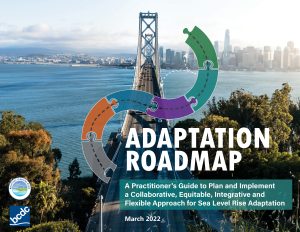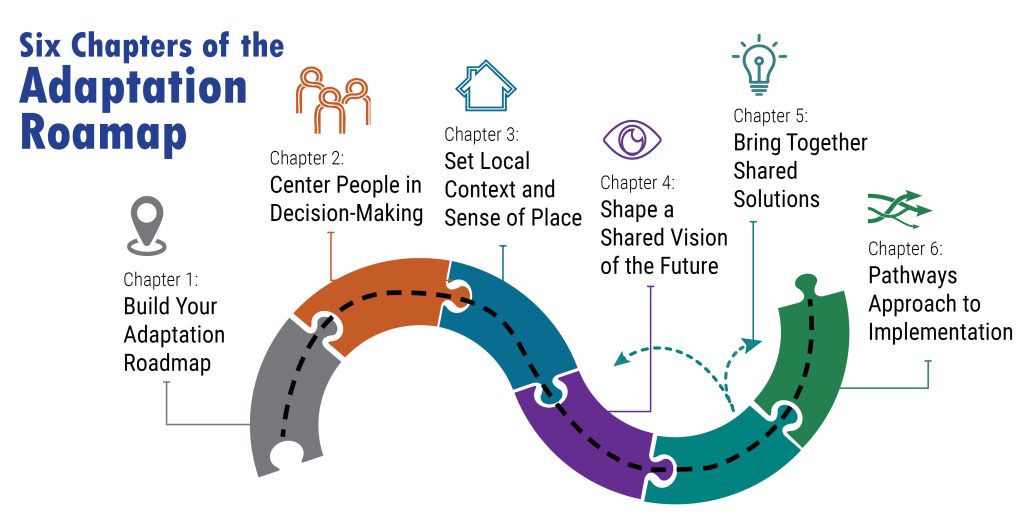 For those who have completed a sea level rise vulnerability assessment, the next step of adaptation planning can seem overwhelming. It can be daunting to think about how to solve the many interconnected, complex, often large-scale challenges associated with the scale and magnitude of the problem. From involving multiple different stakeholders and communities, to navigating the complex landscape of decision-making, addressing historic inequities and injustice, re-building community trust, and making decisions today in the face of uncertainty for both future climate impacts and our societal choices, taking on sea level rise adaptation is complicated.
For those who have completed a sea level rise vulnerability assessment, the next step of adaptation planning can seem overwhelming. It can be daunting to think about how to solve the many interconnected, complex, often large-scale challenges associated with the scale and magnitude of the problem. From involving multiple different stakeholders and communities, to navigating the complex landscape of decision-making, addressing historic inequities and injustice, re-building community trust, and making decisions today in the face of uncertainty for both future climate impacts and our societal choices, taking on sea level rise adaptation is complicated.
The Adaptation Roadmap presents an organizational approach to navigating the key components of sea level rise adaptation. It is a resource that can be viewed in whole or in part, depending on what resources you need and level of detail desired.
Demystifying Local Sea Level Rise Adaptation to Reach Shared Understanding and Outcomes
The Adaptation Roadmap is a solutions-oriented practitioner’s resource for moving beyond sea level rise vulnerability to develop collaboratively built and equitable outcomes to reduce flood risks and prepare communities to make future decisions.
The Adaptation Roadmap introduces the landscape of adaptation, helps users navigate adaptation concepts, supports decision-making for actionable outcomes, and embeds four foundational pillars in adaptation to be collaborative, equitable, integrative, and advance a flexible adaptation pathways approach. It is designed to be an easy-to-navigate resource that provides both a big picture overview of the key components of sea level rise adaptation, and access to in-depth guidance and resources on specific adaptation topics. Read the full report here, or view the 2-page overview here.
Reaching Your Desired Outcomes Through Workbooks
Each of the six chapters of the Adaptation Roadmap have corresponding Workbooks to help users achieve specific outcomes. These Workbooks can be downloaded through the Adaptation Roadmap document, as well as through specific links below.
Project Status
The Adaptation Roadmap and six corresponding Workbooks project began in June 2020 and was completed in March 2022.
Adaptation Roadmap Document and 2-Pager
- The Adaptation Roadmap: A Practitioner’s Guide to Plan and Implement a Collaborative, Equitable, Integrative, and Flexible Approach to Sea Level Rise Adaptation

- 2-Pager Overview of the Adaptation Roadmap

Adaptation Roadmap Workbooks
- Workbook 1: Build Your Adaptation Roadmap

- Workbook 2: Center People in Decision-Making

- Workbook 3: Set Local Context and Sense of Place

- Workbook 4: Shape a Shared Vision of the Future

- Workbook 5: Bring Together Shared Solutions

- Workbook 6: Pathways Approach to Implementation

- ART Adaptation Catalog (Excel document)
Hypothetical Case Studies of Adaptation Roadmap Planning Process
- Suisun City Focus Area: Example Application of Adaptation Roadmap

- Richmond Focus Area: Example Application of Adaptation Roadmap

Training Resources
Related Projects
- Bay Adapt: Regional Strategy for a Rising Bay
- Bridging the Gap: Funding Sea Level Rise Adaptation in the Bay Area

- Sea Level Rise Adaptation Progress, Gaps and Needs

- Shoreline Adaptation Project Mapping
Project Partners
This document was written and designed by Jaclyn Mandoske with support from an Advisory Committee, including: Dana Brechwald, Adapting to Rising Tides Program Manager, BCDC; Julie Beagle, Environmental Planning Section Chief, US Army Corps of Engineers; Claire Bonham-Carter, Vice President, Director of Sustainable Development, AECOM; Allison Brooks, Executive Director, Bay Area Regional Collaborative; Chris Choo, Principal Watershed Planner, Marin County Department of Public Works; Alex Ghenis, Consultant, Accessible Climate Strategies; Nahal Ghoghaie, Environmental Justice Manager, BCDC; Jeremy Lowe, Senior Environmental Scientist, Resilient Landscapes Program, SFEI; Sona Mohnot, Climate Equity Associate Director, Greenlining Institute; Magdalena Sta Maria, Sustainability Analyst, County of Santa Clara Office of Sustainability; Jasneet Sharma, Director, County of Santa Clara Office of Sustainability; Gwen Shaughnessy, Senior Climate Adaptation Specialist, Lynker, LLC for NOAA Office for Coastal Management. Additional thanks to the many individuals who contributed ideas, review, or content to support the Adaptation Roadmap. At the end of each chapter, individuals are acknowledged and thanked as Chapter Contributors.

For more information:
- Jaclyn Mandoske
- Jaclyn.Mandoske@bcdc.ca.gov
